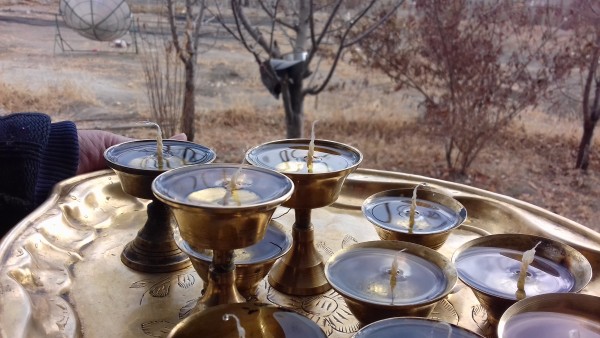
The celebration of New Year among the Buddhist population is known as Losar (Lo-year, sar-new). Date and day of Losar celebration varies each year due to its marking according to the lunar calendar. According to Buddhist history, the great occurrences in Buddha’s life were demarcated as per the lunar cycle therefore the traditional celebrations follow the same accuracy. Losar celebrations initiate a week earlier and within this, occurs a series of celebrations following different rituals and traditions. Galden Namchot is one of the main celebrations among these, it is celebrated on every 25th day of the last month (as per lunar calendar) of the lunar year. On this day, the Buddhist population decorate their houses with lights and butter lamps. It is believed that on this day the great buddhist scholar “Gyalwa Tsongkhapa” was born. Gyalwa Tsongkhapa was a Tibetan monk who is credited to have founded the “Yellow sect” of Tibetan Buddhism. In Ladakh, the yellow sect is one of the two major sects of Tibetan Buddhism along with the “Red hats” (the Drukpas).
In the pre-Buddhist era, the ancestral tribes practiced the Bon religion and the folktales from those times point at evidence of celebrating auspicious days with fire. One of the very popular folktale revolves around a cruel tyrant known as “Cho Bongskang”, who used to devour children of his subjects. He was an invincible being with supernatural origin who couldn’t be brought to an end except that his heart was made of a substance that would melt if set on fire. And so the story continues till his end when the villagers gather their strengths and wits together to kill him by burning him down. Post the end of this tyrant, the villagers were believed to have put on a huge pyre of fire and celebrated their victory over the evil. Hence both tribes in this region of the Himalayas; the Baltis of Baltistan (now Pakistan) and Ladakhis of Ladakh have a celebration that revolves around fire and lighting. The Baltis on the other side of the border, in Skardu they celebrate a fire-night called “Mephang” (throwing of fire). And on the Indian side the Ladakhis, especially the Buddhist community, celebrate Galden Namchot in similar ways. On this day, the families clean their houses and prepare the butter lamps to be lit in the evening. It is the blowing trumpets from the local monasteries that signal the households to start lighting their lamps and while they offer light to each lamp, loud chantings of,”Bulo, Bulo” echo throughout the whole locality. Then the head of the family, usually the patriarch, sits his family down and offers prayers and wishes for a great year ahead from their local deities (these deities are again some of the remnant symbols from the Bon religion). After the offerings are done, the family then feasts upon their festive dishes. Thus with Galden Namchot, the new year celebration gets officially initiated. Right after 5 days from Galden Namchod, Losar is celebrated.